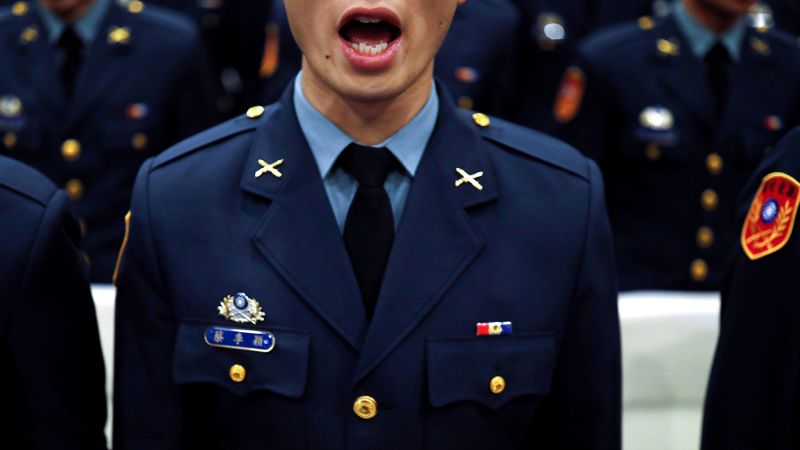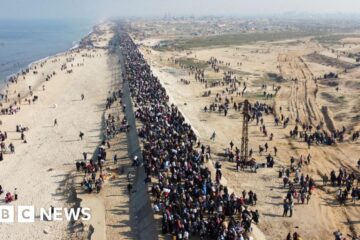
Taipei, Taiwan
CNN
—
Taiwan has noticed a hole in its defense plans that is steadily getting bigger. And it’s not one easily plugged by boosting the budget or buying more weapons.
The island democracy of 23.5 million is facing an increasing challenge in recruiting enough young men to meet its military targets and its Interior Ministry has suggested the problem is – at least in part – due to its stubbornly low birth rate.
Taiwan’s population fell for the first time in 2020, according to the ministry, which warned earlier this year that the 2022 military intake would be the lowest in a decade and that a continued drop in the youth population would pose a “huge challenge” for the future.
That’s bad news at a time when Taiwan is trying to bolster its forces to deter any potential invasion by China, whose ruling Communist Party has been making increasingly belligerent noises about its determination to “reunify” with the self-governed island – which it has never controlled – by force if necessary.
And the outlook has darkened further with the release of a new report by Taiwan’s National Development Council projecting that by 2035 the island can expect roughly 20,000 fewer births per year than the 153,820 it recorded in 2021. By 2035, Taiwan will also overtake South Korea as the jurisdiction with the world’s lowest birth rate, the report added.
Such projections are feeding into a debate over whether the government should increase the period of mandatory military service that eligible young men must serve. Currently, the island has a professional military force made up of 162,000 (as of June this year) – 7,000 fewer than the target, according to a report by the Legislative Yuan. In addition to that number, all eligible men must serve four months of training as reservists.
Changing the mandatory service requirement would be a major U-turn for Taiwan, which had previously been trying to cut down on conscription and shortened the mandatory service from 12 months as recently as 2018. But on Wednesday, Taiwan’s Minister of National Defence Chiu Kuo-cheng said such plans would be made public before the end of the year.
That news has met with opposition among some young students in Taiwan, who have voiced their frustrations on PTT, Taiwan’s version of Reddit, even if there is support for the move among the wider public.
A poll by the Taiwanese Public Opinion Foundation in March this year found that most Taiwanese agreed with a proposal to lengthen the service period. It found that 75.9% of respondents thought it reasonable to extend it to a year; only 17.8% were opposed.
Many experts argue there is simply no other option.
Su Tzu-yun, a director of Taiwan’s Institute for National Defense and Security Research, said that before 2016, the pool of men eligible to join the military – either as career soldiers or as reservists – was about 110,000. Since then, he said, the number had declined every year and the pool would likely be as low as 74,000 by 2025.
And within the next decade, Su said, the number of young adults available for recruitment by the Taiwanese military could drop by as much as a third.
“This is a national security issue for us,” he said. “The population pool is decreasing, so we are actively considering whether to resume conscription to meet our military needs.
“We are now facing an increasing threat (from China), and we need to have more firepower and manpower.”
Taiwan’s low birth rate – 0.98 – is far below the 2.1 needed to maintain a stable population, but it is no outlier in East Asia.
In November, South Korea broke its own world record when its birth rate dropped to 0.79, while Japan’s fell to 1.3 and mainland China hit 1.15.
Even so, experts say the trend poses a unique problem for Taiwan’s military, given the relative size of the island and the threats it faces.
China has been making increasingly aggressive noises toward the island since August, when then-US House Speaker Nancy Pelosi controversially visited Taipei. Not long after she landed in Taiwan, Beijing also launched a series of unprecedented military exercises around the island.
Since then, the temperature has remained high – particularly as Chinese leader Xi Jinping told a key Communist Party meeting in October that “reunification” was inevitable and that he reserves the option of taking “all measures necessary.”
Chang Yan-ting, a former deputy commander of Taiwan’s air force, said that while low birth rates were common across East Asia, “the situation in Taiwan is very different” as the island was facing “more and more pressure (from China) and the situation will become more acute.”
“The United States has military bases in Japan and South Korea, while Singapore does not face an acute military threat from its neighbors. Taiwan faces the greatest threat and declining birth rate will make the situation even more serious,” he added.
Roy Lee, a deputy executive director at Taiwan’s Chung-hua Institution for Economic Research, agreed that the security threats facing Taiwan were greater than those in the rest of the region.
“The situation is more challenging for Taiwan, because our population base is smaller than other countries facing similar problems,” he added.
Taiwan’s population is 23.5 million, compared to South Korea’s 52 million, Japan’s 126 million and China’s 1.4 billion.
Besides the shrinking recruitment pool, the decline in the youth population could also threaten the long-term performance of Taiwan’s economy – which is itself a pillar of the island’s defense.
Taiwan is the world’s 21st largest economy, according to the London-based Centre for Economics and Business Research, and had a GDP of $668.51 billion last year.
Much of its economic heft comes from its leading role in the supply of semiconductor chips, which play an indispensable role in everything from smartphones to computers.
Taiwan’s homegrown semiconductor giant TSMC is perceived as being so valuable to the global economy – as well as to China – that it is sometimes referred to as forming part of a “silicon shield” against a potential military invasion by Beijing, as its presence would give a strong incentive to the West to intervene.
Lee noted that population levels are closely intertwined with gross domestic product, a broad measure of economic activity. A population decline of 200,000 people could result in a 0.4% decline in GDP, all else being equal, he said.
“It is very difficult to increase GDP by 0.4%, and would require a lot of effort. So the fact that a declining population can take away that much growth is big,” he said.
Taiwan’s government has brought in a series of measures aimed at encouraging people to have babies, but with limited success.
It pays parents a monthly stipend of 5,000 Taiwan dollars (US$161) for their first baby, and a higher amount for each additional one.
Since last year, pregnant women have been eligible for seven days of leave for obstetrics checks prior to giving birth.
Outside the military, in the wider economy, the island has been encouraging migrant workers to fill job vacancies.
Statistics from the National Development Council showed that about 670,000 migrant workers were in Taiwan at the end of last year – comprising about 3% of the population.
Most of the migrant workers are employed in the manufacturing sector, the council said, the vast majority of them from Vietnam, Indonesia, Thailand and the Philippines.
Lee said in the long term the Taiwanese government would likely have to reform its immigration policies to bring in more migrant workers.
Still, there are those who say Taiwan’s low birth rate is no reason to panic, just yet.
Alice Cheng, an associate professor in sociology at Taiwan’s Academia Sinica, cautioned against reading too much into population trends as they were affected by so many factors.
She pointed out that just a few decades ago, many demographers were warning of food shortages caused by a population explosion.
And even if the low birth rate endured, that might be no bad thing if it were a reflection of an improvement in women’s rights, she said.
“The educational expansion that took place in the 70s and 80s in East Asia dramatically changed women’s status. It really pushed women out of their homes because they had knowledge, education and career prospects,” she said.
“The next thing you see globally is that once women’s education level improved, fertility rates started declining.”
“All these East Asian countries are really scratching their head and trying to think about policies and interventions to boost fertility rates,” she added.
“But if that’s something that really, (women) don’t want, can you push them to do that?”
Note:- (Not all news on the site expresses the point of view of the site, but we transmit this news automatically and translate it through programmatic technology on the site and not from a human editor. The content is auto-generated from a syndicated feed.))




I was suggested this web site by way of my cousin. I’m no longer certain whether this put up is written by means of him as nobody else realize such specific about my difficulty.
You’re amazing! Thank you!
Thanks very interesting blog!
What’s Going down i’m new to this, I stumbled upon this
I’ve discovered It positively helpful and it has helped me out loads.
I hope to contribute & help other users like its aided me.
Good job. https://cl-system.jp/question/tout-ce-que-vous-devez-savoir-sur-lassurance-habitation-au-quebec-8/
I am really pleased to read this blog posts which consists of plenty of valuable facts, thanks for providing these kinds of
information.